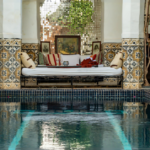Marrakech is a city where history breathes through every narrow alley and vibrant market. Among its myriad of cultural treasures, the art of henna tattooing stands out as a time-honored tradition. Authentic henna tattoos in Marrakech are more than just body art—they are a deep-rooted expression of cultural identity, storytelling, and spirituality. This article explores the origin, history, and artistry behind henna tattoos in Marrakech, guiding you on an immersive journey into a world of intricate designs and ancient rituals. Whether you’re a traveler, art enthusiast, or simply curious about this enduring craft, read on to uncover the secrets behind authentic henna in Marrakech.

The Origins of Henna Tattoos
Henna, derived from the Lawsonia inermis plant, has been used for millennia. Its application began in ancient civilizations where it served as a natural dye and a ceremonial adornment. In these early days, henna was not just a cosmetic application but a symbolic expression of life, fertility, and protection. The natural pigment from henna leaves was revered for its ability to bring luck and ward off evil, establishing the foundation of what would become a celebrated art form.
Historical Beginnings
Long before the bustling markets of Marrakech, henna was utilized across North Africa, the Middle East, and South Asia. Archaeological evidence suggests that henna was used by ancient Egyptians and Mesopotamians for both decorative and medicinal purposes. Its role in rituals and celebrations speaks to its enduring significance in human culture. The passage of henna from one generation to another was a tradition that held as much spiritual power as it did aesthetic appeal.

Evolution of Henna Art in Marrakech
In Marrakech, henna art evolved uniquely under the influence of Berber and Arab cultures. The indigenous Berbers, known for their rich artistic heritage, introduced intricate geometric patterns and symbolic motifs. These traditional designs were later interwoven with Arab artistic sensibilities, characterized by fluid curves and elaborate calligraphy. The fusion of these influences resulted in a distinctive style that is both dynamic and steeped in history.

The Cultural Significance of Henna Tattoos
Henna tattoos carry deep cultural meanings. They are often associated with rites of passage such as weddings, births, and religious festivities. The application of henna is a celebratory act—a mark of joy, transition, and the welcoming of prosperity. In many Moroccan communities, a henna design is seen as a blessing, a form of protection against misfortune and ill-will. The patterns often incorporate symbols of nature, love, and spirituality, making each design a unique narrative of the wearer’s personal and cultural journey.

Traditional Techniques and Materials
Authentic henna art is rooted in the use of natural, locally-sourced materials. The henna plant, cultivated in arid regions, produces leaves that are carefully dried and ground into a fine powder. This powder is then mixed with natural liquids like lemon juice or tea to create a smooth, paste-like consistency. Traditional methods emphasize the importance of freshness and purity in the ingredients to ensure the deep, rich color characteristic of a high-quality henna tattoo.
- Natural Ingredients and Their Sourcing:
The authenticity of a henna tattoo is largely dependent on the quality of its ingredients. Many artisans in Marrakech pride themselves on using organic henna leaves, free from chemical additives, to preserve both the natural color and the integrity of the design. - The Process of Creating Authentic Henna Paste:
Creating the perfect henna paste is an art in itself. It involves not only the meticulous selection and grinding of the leaves but also the careful mixing with other natural enhancers. This process is often accompanied by rituals and personal touches, passed down through generations, ensuring that every paste holds a unique essence.

The Artistry Behind Henna Designs
The beauty of henna lies in its intricate designs. Each pattern is a blend of cultural symbolism and personal expression. Common motifs include floral patterns, geometric shapes, and symbolic representations of nature. These designs are not random; they are meticulously planned and executed with a precision that reflects the artist’s skill and cultural understanding.
- Common Motifs and Patterns:
Traditional Moroccan henna designs often incorporate elements such as vines, leaves, and mandala-like circles. These motifs are believed to represent the continuity of life, growth, and the connection between the earthly and the spiritual. - Regional Variations in Design:
While there are common themes across Morocco, each region boasts its own unique style. Marrakech, in particular, is renowned for designs that are both bold and delicate, a juxtaposition that mirrors the city’s vibrant yet serene ambiance.

The History of Henna Tattoos in Marrakech
Marrakech’s rich history is intertwined with the story of henna. Over centuries, the art form has been refined and celebrated, becoming an integral part of local identity. Historically, henna was applied by skilled women during significant life events. Over time, its usage expanded beyond ceremonial purposes, becoming a popular form of body art for both locals and visitors.
- Key Historical Periods:
From the era of ancient Berber tribes to the modern cosmopolitan period, henna has consistently been a symbol of cultural pride. During festivals and major life events, families would gather to celebrate, and the henna artist’s role was as revered as that of a storyteller. - Impact of Trade and Migration:
Marrakech has long been a crossroads of trade and culture. The movement of people along the historic Silk Road and other trade routes introduced new design elements and techniques. This blending of influences enriched the local tradition, making henna a dynamic art form that continues to evolve.

Modern Interpretations of Henna Art
While deeply rooted in tradition, henna art in Marrakech has adapted to contemporary tastes. Modern henna designs often incorporate elements of minimalism and modern art while retaining the intricate detail of traditional motifs. This evolution is reflective of a broader cultural trend where heritage and modernity coexist harmoniously.
- Contemporary Trends:
Today, many young artists experiment with fusion designs, blending the old with the new. This has led to innovative interpretations that appeal to both locals and international visitors seeking a modern twist on a timeless art. - Fusion of Traditional and Modern Styles:
This blend of tradition and modernity ensures that henna art remains relevant. It also offers artists a broader canvas for creativity, pushing the boundaries of conventional design while honoring its historical roots.

Visiting Marrakech for an Authentic Henna Experience
A trip to Marrakech offers more than just sightseeing; it provides an immersive cultural experience. For those interested in henna art, the city offers countless opportunities to witness and partake in this ancient craft. The vibrant markets, bustling streets, and age-old traditions all come together to create a truly authentic experience.
- Cultural Immersion in the City:
Wandering through Marrakech, you’ll notice henna being applied in cafes, at weddings, and even on the streets. The act of getting a henna tattoo is not just about adornment; it’s an invitation to engage with the local culture and history. - Exploring Local Traditions:
Beyond the art itself, visitors can learn about the rituals and ceremonies that accompany the application of henna. This holistic experience offers insights into the spiritual and social fabric of Marrakech.
The Role of Jamaa EL-Fna in Henna Art
At the heart of Marrakech’s cultural scene lies Jamaa EL-Fna, a bustling square renowned for its dynamic energy and rich traditions. This iconic location is a hub where the art of henna finds a vibrant expression. Here, skilled henna artists set up their stations, drawing crowds with their intricate and mesmerizing designs.
- Overview of Jamaa EL-Fna:
Jamaa EL-Fna is not just a tourist attraction; it is a living museum of Moroccan culture. The square is alive with music, storytelling, and artistic expression, making it an ideal spot to witness authentic henna art in action. - Why It Is a Must-Visit for Henna Enthusiasts:
For anyone seeking an authentic henna experience, Jamaa EL-Fna offers the perfect blend of tradition, artistry, and community spirit. The spontaneous interactions and the palpable energy of the place provide an unforgettable experience that encapsulates the essence of Marrakech.

Booking Your Stay in Marrakech
Planning a visit to Marrakech can be as exciting as the journey itself. For a seamless travel experience, consider booking your stay through MorocConnect.net. This platform offers comprehensive travel resources, including lodging options, local guides, and cultural recommendations. It’s a one-stop solution for travelers seeking an authentic Moroccan adventure.
- Introduction to MorocConnect.net:
MorocConnect.net is dedicated to connecting visitors with the true essence of Morocco. Their platform is designed to help you plan every aspect of your trip, from accommodations to cultural experiences. This ensures that your visit to Marrakech is not just a trip, but a journey into the heart of Moroccan life. - Tips for Planning Your Trip:
When booking your stay, consider the proximity to cultural hotspots like Jamaa EL-Fna. This way, you can immerse yourself in the local culture and easily access the best henna tattoo experiences. Additionally, check for travel tips, local guides, and personalized itineraries available on MorocConnect.net.
Safety and Authenticity: What to Expect
In a city as bustling as Marrakech, ensuring an authentic and safe henna tattoo experience is paramount. When you choose a reputable henna artist, you are guaranteed not only quality artistry but also a culturally respectful and enriching encounter.
- Ensuring Genuine Henna Experiences:
Always look for artists who emphasize the use of natural ingredients and traditional techniques. Their commitment to authenticity is evident in the care they take with every design. Genuine henna tattoos are a blend of art, tradition, and personal expression. - Avoiding Tourist Traps:
While Marrakech is a popular tourist destination, some areas may offer inauthentic or overly commercialized henna experiences. By relying on trusted recommendations—such as visiting Jamaa EL-Fna and booking through MorocConnect.net—you can avoid these pitfalls and enjoy a truly cultural experience.
Practical Tips for First-Time Visitors
For those new to Marrakech and henna art, a little preparation goes a long way. Understanding local customs and knowing what to expect can make your experience smoother and more enjoyable.
- What to Bring and How to Prepare:
Lightweight clothing, comfortable footwear, and a spirit of adventure are essential. Marrakech can be hot, so dress appropriately and carry sun protection. Familiarize yourself with local etiquette—greetings, modest dress, and respect for traditions are key to a positive experience. - Respecting Local Customs:
When visiting henna artists or local markets, remember that you are entering a vibrant cultural space. Engage respectfully, ask questions, and embrace the opportunity to learn from the local traditions. This respectful curiosity will enrich your overall experience.
The Future of Henna Tattoo Art
As with many traditional art forms, henna is evolving in the modern era. Yet, despite these changes, the heart of henna art—its cultural and spiritual significance—remains steadfast.
- Preservation of Traditional Methods:
Many artisans are dedicated to preserving the ancient techniques of henna application. Through workshops, cultural festivals, and local community centers, the legacy of authentic henna art is being passed down to future generations. - Innovations in Henna Application:
Modern technology and global influences have also introduced new methods and creative styles. However, these innovations never compromise the core values of the art. Instead, they offer fresh perspectives, ensuring that henna remains a living tradition, adaptable yet timeless.
Conclusion and Final Thoughts
In Marrakech, henna tattoos are not merely a fashion statement—they are an embodiment of centuries-old traditions, cultural narratives, and personal expressions. The intricate designs and deep symbolism reflect a journey that spans generations, melding history with modernity. Whether you choose to get a tattoo in the lively ambiance of Jamaa EL-Fna or book your immersive stay via MorocConnect.net, you are stepping into a world where art, culture, and history converge. Embrace this experience, and you’ll discover that every henna design tells a unique story—your story, intertwined with the rich legacy of Marrakech.
FAQs
Q1: What makes authentic henna tattoos in Marrakech unique?
Authentic henna tattoos in Marrakech are renowned for their deep cultural roots, blending Berber and Arab artistic influences, and utilizing natural ingredients to create intricate and meaningful designs.
Q2: How can I ensure that I get a genuine henna tattoo experience in Marrakech?
Look for skilled local artists who use traditional methods and natural henna paste. Visiting reputable locations like Jamaa EL-Fna and booking your stay through trusted platforms like MorocConnect.net can also enhance authenticity.
Q3: What are some traditional motifs commonly seen in Moroccan henna designs?
Common motifs include floral patterns, geometric shapes, and mandala-like designs, all symbolizing aspects of nature, life, and spirituality.
Q4: How has modern influence affected traditional henna art in Marrakech?
Modern influences have introduced fusion designs that blend traditional motifs with contemporary styles, expanding the art’s appeal while still honoring its historical significance.
Q5: What should first-time visitors to Marrakech know about henna tattoo traditions?
First-time visitors should be open to cultural immersion, respect local customs, and prepare for an authentic experience by learning about the traditional significance of henna tattoos, ensuring they visit reputable areas like Jamaa EL-Fna.





